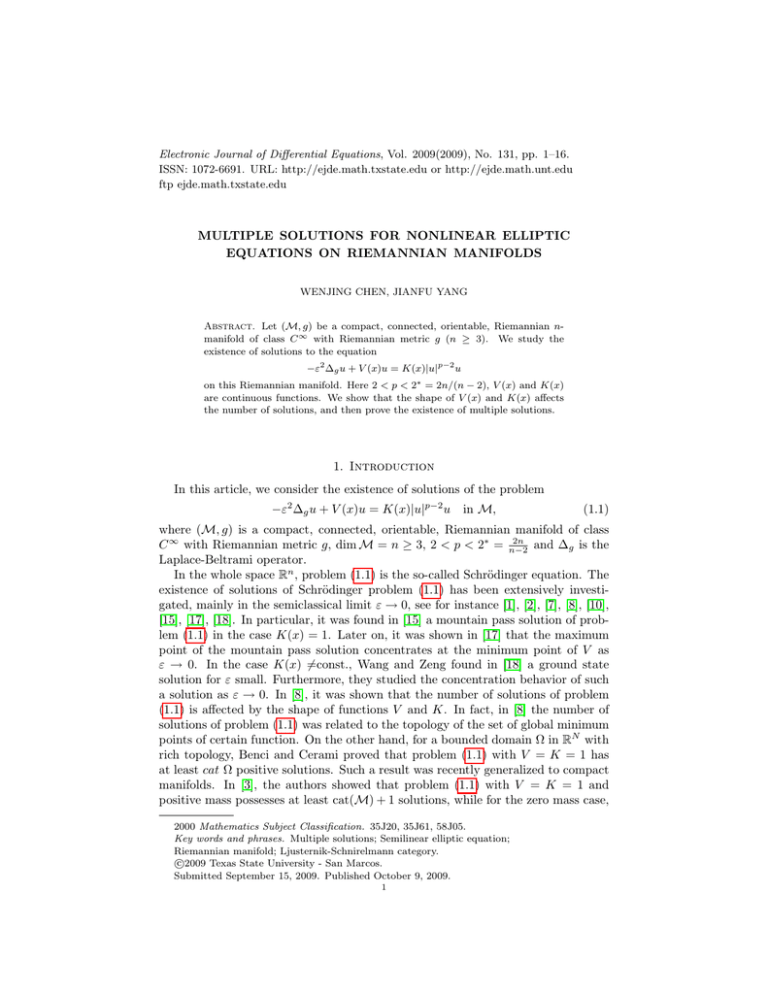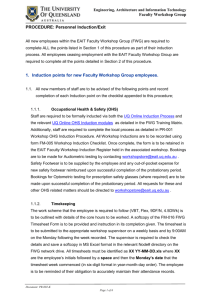Electronic Journal of Differential Equations, Vol. 2009(2009), No. 131, pp.... ISSN: 1072-6691. URL: or
advertisement

Electronic Journal of Differential Equations, Vol. 2009(2009), No. 131, pp. 1–16.
ISSN: 1072-6691. URL: http://ejde.math.txstate.edu or http://ejde.math.unt.edu
ftp ejde.math.txstate.edu
MULTIPLE SOLUTIONS FOR NONLINEAR ELLIPTIC
EQUATIONS ON RIEMANNIAN MANIFOLDS
WENJING CHEN, JIANFU YANG
Abstract. Let (M, g) be a compact, connected, orientable, Riemannian nmanifold of class C ∞ with Riemannian metric g (n ≥ 3). We study the
existence of solutions to the equation
−ε2 ∆g u + V (x)u = K(x)|u|p−2 u
on this Riemannian manifold. Here 2 < p < 2∗ = 2n/(n − 2), V (x) and K(x)
are continuous functions. We show that the shape of V (x) and K(x) affects
the number of solutions, and then prove the existence of multiple solutions.
1. Introduction
In this article, we consider the existence of solutions of the problem
−ε2 ∆g u + V (x)u = K(x)|u|p−2 u
in M,
(1.1)
where (M, g) is a compact, connected, orientable, Riemannian manifold of class
2n
and ∆g is the
C ∞ with Riemannian metric g, dim M = n ≥ 3, 2 < p < 2∗ = n−2
Laplace-Beltrami operator.
In the whole space Rn , problem (1.1) is the so-called Schrödinger equation. The
existence of solutions of Schrödinger problem (1.1) has been extensively investigated, mainly in the semiclassical limit ε → 0, see for instance [1], [2], [7], [8], [10],
[15], [17], [18]. In particular, it was found in [15] a mountain pass solution of problem (1.1) in the case K(x) = 1. Later on, it was shown in [17] that the maximum
point of the mountain pass solution concentrates at the minimum point of V as
ε → 0. In the case K(x) 6=const., Wang and Zeng found in [18] a ground state
solution for ε small. Furthermore, they studied the concentration behavior of such
a solution as ε → 0. In [8], it was shown that the number of solutions of problem
(1.1) is affected by the shape of functions V and K. In fact, in [8] the number of
solutions of problem (1.1) was related to the topology of the set of global minimum
points of certain function. On the other hand, for a bounded domain Ω in RN with
rich topology, Benci and Cerami proved that problem (1.1) with V = K = 1 has
at least cat Ω positive solutions. Such a result was recently generalized to compact
manifolds. In [3], the authors showed that problem (1.1) with V = K = 1 and
positive mass possesses at least cat(M) + 1 solutions, while for the zero mass case,
2000 Mathematics Subject Classification. 35J20, 35J61, 58J05.
Key words and phrases. Multiple solutions; Semilinear elliptic equation;
Riemannian manifold; Ljusternik-Schnirelmann category.
c
2009
Texas State University - San Marcos.
Submitted September 15, 2009. Published October 9, 2009.
1
2
W. CHEN, J. YANG
EJDE-2009/131
similar results were obtained in [16]. Inspired by [3], [8] and [16], we consider in
this paper the effect of coefficients V, K on the existence of number of solutions.
Problem (1.1) is related to the problem
−∆u + V (η)u = K(η)|u|p−2 u
in Rn
(1.2)
in Rn u > 0,
(1.3)
for fixed η ∈ M. It is well known that the problem
−∆u + u = |u|p−2 u
has a positive radial solution U ; see for instance [5]. The function U and its radial
derivatives satisfy the following decaying law
U (r) ∼ e−|r| |r|−
n−1
2
U 0 (r)
= 1,
r→∞ U (r)
,
lim
r = |x|.
By a result in [13], U is the unique
solution of problem (1.3). We may
positive
1/2 V (η) 1/(p−2)
U V (η)
z with K(η) > 0 is a ground state
verify that w(z) := K(η)
solution of problem (1.2); that is, it is the minimizer of the variational problem
cη := inf Eη (u),
u∈Nη
where
Z
Z
1
1
(|∇u|2 + V (η)u2 ) dz −
K(η)|u|p dz
2 Rn
p Rn
is the associated energy functional of problem (1.2) and
Z
Z
Nη := u ∈ H 1 (Rn )\{0} :
(|∇u|2 + V (η)u2 ) dz =
K(η)|u|p dz
Eη (u) =
Rn
Rn
is the related Nehari manifold. In fact,
p
cη = Eη (w) =
n
1 1 V p−2 − 2 (η)
−
2
2 p K p−2
(η)
Z
|U (z)|p dz.
Rn
Let
c0 = inf cη
η∈M
and Ω := {η ∈ M : cη = c0 }.
For δ > 0 let
Ωδ := {ξ ∈ M : inf kξ − ηkg ≤ δ}.
η∈Ω
We assume in this paper that V, K ∈ C(M, R) and there is a positive number ν > 0
such that V, K ≥ ν > 0. Denote by catX (A) the Ljusternik-Schirelmann category
of A in X. Let
Kmax = max K(x), Kmin = min K(x).
x∈M
x∈M
Our main result is the following.
Theorem 1.1. Problem (1.1) has at least catΩδ (Ω) positive solutions for ε > 0
small.
Solutions of problem (1.1) will be found as critical points of the associated functional
Z
Z
1 1
1
2
2
2
Iε (u) = n
ε |∇g u(x)| + V (x)u dµg −
K(x)|u+ |p dµg ,
ε 2 M
p M
EJDE-2009/131
MULTIPLE SOLUTIONS
3
in the Hilbert space
Hg1 (M) := u : M → R :
Z
(|∇g u|2 + u2 ) dµg < ∞
M
with the norm
Z
kukg =
(|∇g u|2 + u2 ) dµg
1/2
,
M
√
where dµg = det gdz denotes the volume form on M associated with the metric
g. For σ > 0, let
Σε,σ := {u ∈ Nε : Iε (u) < c0 + σ}
be a subset of the Nehari manifold
Z
Z
Nε := u ∈ Hg1 (M)\{0} :
(ε2 |∇g u(x)|2 + V (x)u2 ) dµg =
K(x)|u+ |p dµg
M
M
related to the functional Iε . To prove Theorem 1.1, we first show that problem
(1.1) has at least catΣε,σ Σε,σ solutions, then we need to relate catΣε,σ Σε,σ with
catΩδ Ω. By a result in [11], we know that M can be isometrically embedded in a
Euclidean space RN as a regular sub-manifold with N > 2n. For any set ω ⊂ M
and r > 0, we define
[ω]r := {z ∈ RN : dist(z, ω) ≤ r}
N
a subset of R , where dist(z, ω) denotes the distance between z and ω with respect
to the Euclidian metric in RN . Let r = r(Ωδ ) be the radius of topological invariance
of Ωδ , which is defined by
r(Ωδ ) := sup{l > 0 : cat([Ωδ ]l ) = cat(Ωδ )}.
We choose r > 0 so small that the metric projection
Π : [Ωδ ]r ⊂ RN → Ωδ
is well defined. We will construct a function φε : Ω → Σε,σ and a function β :
Σε,σ → [Ωδ ]r such that
φε
β
Π
Ω −→ Σε,σ −
→ [Ωδ ]r −
→ Ωδ ,
and Π ◦ β ◦ φε is homotopic to the identity on Ωδ . It implies that catΣε,σ Σε,σ ≥
catΩδ Ω.
In section 2, we outline our frame of work. The mappings φε and β are constructed in section 3 and section 4 respectively.
2. The framework and preliminary results
Let M be a compact Riemannian manifolds of class C ∞ . On the tangent bundle
of M we define the exponential map exp : T M → M which has the following
properties:
(i) exp is of class C ∞ ; (ii) there exists a constant R > 0 such that
expx B(0,R) : B(0, R) → Bg (x, R) is a diffeomorphism for all x ∈ M. Fix such an
R in this paper and denote by B(0, R) the ball in Rn centered at 0 with radius R
and Bg (x, R) the ball in M centered at x with radius R with respect to the distance
induced by the metric g. Let C be the atlas on M whose charts are given by the
exponential map and P = {ψC }C∈C be a partition of unity subordinate to the atlas
C. For u ∈ Hg1 (M), we have
Z
XZ
2
|∇g u| dµg =
ψC (x)|∇g u|2 dµg .
M
C∈C
C
4
W. CHEN, J. YANG
EJDE-2009/131
Moreover, if u has support inside one chart C = Bg (η, R), then
Z
|∇g u|2 dµg
M
Z
∂u(expx0 (z)) ∂u(expx0 (z))
=
ψC (expx0 (z))gxij0 (z)
|gx0 (z)|1/2 dz,
∂z
∂z
i
j
B(0,R)
where gx0 denotes the Riemannian metric reading in B(0, R) through the normal
coordinates defined by the exponential map expx0 . In particular, gx0 (0) = Id. We
let |gx0 (z)| := det(gx0 (z)) and (gxij0 )(z) is the inverse matrix of gx0 (z). Since M is
compact, there are two strictly positive constants h and H such that
∀x ∈ M,
∀υ ∈ Tx M,
hkυk2 ≤ gx (υ, υ) ≤ Hkυk2 .
Hence, we have
∀x ∈ M, hn ≤ |gx | ≤ H n .
Theorem 1.1 will follow from the following result in [14].
Proposition 2.1. Let N be a C 1,1 complete Riemannian manifold modeled on a
Hilbert space and J be a C 1 functional on N bounded from below. If there exists b >
inf N J such that J satisfies the Palais-Smale condition on the sublevel J −1 (−∞, b),
then for any noncritical level a, with a < b, there exist at least catJ a (J a ) critical
points of J in J a , where J a := {u ∈ N |J(u) ≤ a}.
We need also the following Lemma.
Lemma 2.2. Let X and Y be topological spaces, Z ⊂ Y be a closed set and h1 ∈
C(Z, X), h2 ∈ C(X, Y ) with h2 being a closed mapping. Suppose that h2 ◦ h1 : Z →
Y is homotopic to the identity mapping Id in Y , then catX (X) ≥ catY (Z).
Proof.
Let k = catX (X), there exist closed sets V1 , V2 , · · · , Vk such that X =
S
1≤i≤k Vi and each Vi is contractible in X. Since h2 ∈ C(X, Y ) and h2 being a
closed mapping, each h2 (Vi ) is closed and contractible in Y , then
catX (X) ≥ catY (h2 (X)).
(2.1)
Since h2 ◦ h1 (Z) ⊂ h2 (X), we have
catY (h2 (X)) ≥ catY (h2 ◦ h1 (Z)).
(2.2)
On the other hand, h2 ◦ h1 : Z → Y is homotopic to the identity mapping Id in Y ,
thus
catY (h2 ◦ h1 (Z)) ≥ catY (Z).
(2.3)
By (2.1)-(2.3), catX (X) ≥ catY (Z).
3. The function φε
We know that Nε is a C 1,1 manifold. If u ∈ Nε , we have kukg ≥ C > 0,
C is independent of u. For u ∈ Hg1 (M), there exists a unique tε (u) > 0, tε :
Hg1 (M)\{0} → R+ , such that tε (u)u ∈ Nε and
Iε (tε (u)u) = max Iε (tu).
t≥0
More precisely,
R
tp−2
(u)
ε
=
M
ε2 |∇g u(x)|2 + V (x)u2 dµg
R
.
K(x)|u+ |p dµg
M
(3.1)
EJDE-2009/131
MULTIPLE SOLUTIONS
5
The function tε (u) is C 1 . Let us define a smooth real function χR on R+ such that
(
1 if 0 ≤ t ≤ R2 ;
χR (t) :=
(3.2)
0 if t ≥ R .
and |χ0R (t)| ≤
2
R.
Fixing η ∈ Ω and ε > 0, we define
(
−1
wε (exp−1
η (x))χR (| expη (x)|) if x ∈ Bg (η, R);
Wη,ε (x) :=
0
otherwise,
(3.3)
where w(z) is the ground state solution of problem (1.2) and wε (z) = w( zε ). We
define φε : Ω → Nε by
φε (η) = tε (Wη,ε (x))Wη,ε (x).
(3.4)
Lemma 3.1. With the above notation, we have
Z
Z
1
2
2
ε
|∇
W
(x)|
dµ
→
|∇w|2 dz as ε → 0.
g η,ε
g
εn M
Rn
Z
Z
1
2
V (x)|Wη,ε (x)| dµg →
V (η)w2 (z)dz as ε → 0,
εn M
Rn
Z
Z
1
p
K(x)|Wη,ε (x)| µg →
K(η)wp (z)dz as ε → 0.
εn M
n
R
(3.5)
(3.6)
(3.7)
Proof. We have
Z
1 Z
2
2
ε |∇g Wη,ε (x)| dµg −
|∇w|2 dz n
ε M
n
R
Z
1 Z
2
2
−1
2
= n
dµ
−
|∇w|
dz
ε ∇g wε (expη (x))χR (| exp−1
(x)|)
g
η
ε Bg (η,R)
n
R
Z
1 Z
2
2
1/2
= n
ε ∇ (wε (z)χR (|z|)) g |gη (z)| dz −
|∇w|2 dz ε B(0,R)
n
R
Z
Z
2
1/2
=
dz −
|∇w|2 dz ∇ w(z)χ Rε (|z|) |gη (εz)|
Z
≤
g
B(0, R
ε )
n
X
Rn
Rn
∂w(z) ∂w(z) 2
χ R (|z|)gηij (εz)|gη (εz)|1/2 − δij dz
ε
∂z
∂z
i
j
i,j=1
Z
+
Rn
n
X
gηij (εz)χ R (|z|)w(z)
ε
i,j=1
∂w ∂χ Rε (|z|)
∂w ∂χ Rε (|z|)
+
∂zi ∂zj
∂zj
∂zi
!
|gη (εz)|1/2 dz
n
X
∂χ R (|z|) ∂χ R (|z|) ε
ε
+
gηij (εz)w2 (z)
|gη (εz)|1/2 dz := I1 + I2 + I3 .
∂zi
∂zj
Rn i,j=1
Z
By the compactness of the manifold M and regularity of the exponential map of
the Riemannian metric g, we have
lim χ2R (|z|)gηij (εz)|gη (εz)|1/2 − δij = 0
ε→0
ε
uniformly with respect to η ∈ Ω, so I1 → 0 as ε → 0. By the definition of χR (t),
Z X
n
∂w ∂χ R (|z|)
H n/2
∂w ∂χ Rε (|z|) ε
I2 ≤
w(z)
+
dz
h
∂zi ∂zj
∂zj
∂zi
Rn i,j=1
6
W. CHEN, J. YANG
4H n/2 ε
Rh
Z
4H n/2 ε
=
Rh
≤
EJDE-2009/131
|w(z)| |∇w(z)| dz
Rn
V (η)
K(η)
2
2/(p−2)
n
2H n/2 ε V p−2 − 2 (η)
≤
2
Rh
K p−2 (η)
V (η)−n/2
Z
|U (z)| |∇U (z)| dz
Rn
Z
(|∇U (z)|2 + |U (z)|2 ) dz.
Rn
Similarly,
2
n
H n/2 4ε2 V p−2 − 2 (η)
I3 ≤
2
h R2 K p−2
(η)
Z
U (z)2 dz.
Rn
Hence, I2 + I3 → 0 uniformly with respect to η ∈ Ω as ε → 0 and (3.5) follows.
Next, we prove (3.6). We have
Z
1 Z
2
V (x)|Wη,ε (x)| dµg −
V (η)w2 (z)dz n
ε M
Rn
Z
1 Z
−1
2
V (x)|wε (expη (x))χR (| exp−1
= n
(x)|)|
dµ
−
V (η)w2 (z)dz g
η
ε Bg (η,R)
n
R
Z
1 Z
V (expη (z))|wε (z)χR (|z|)|2 |gη (z)|1/2 dz −
V (η)w2 (z)dz = n
ε B(0,R)
n
R
Z
Z
=
V (expη (εz))|w(z)χR (|εz|)|2 |gη (εz)|1/2 dz −
V (η)w2 (z) dz B(0, R
ε )
Rn
Z h
i
≤
V (expη (εz))|χR (|εz|)|2 |gη (εz)|1/2 − V (η) w2 (z)dz Rn
Z
h
i
+
V (expη (εz))|χR (|εz|)|2 |gη (εz)|1/2 − V (η) w2 (z)dz Rn \B(0, R
ε )
:= I4 + I5 .
We note that expη (εz) → η and gη (εz) → δij as ε → 0, by the continuity of V ,
I4 → 0. Obviously, I5 → 0. So (3.6) holds. (3.7) can be proved in the same
way.
Proposition 3.2. For ε > 0, the map φε : Ω → Nε is continuous; and for any
σ > 0, there exists ε0 > 0 such that if ε < ε0 φε (η) ∈ Σε,σ for all η ∈ Ω.
Proof. The continuity of φε can be proved as [3, Proposition 4.2], so we omit the
details. Now, we show φε (η) ∈ Σε,σ for ∀η ∈ Ω. By Lemma 3.1,
R
R
2
1
2
2
dµg + ε1n M V (x) (Wη,ε (x)) dµg
p−2
εn M ε |∇g Wη,ε (x)(x)|
R
tε (Wη,ε (x)) =
+
1
p
εn M K(x)|Wη,ε (x)| dµg
R
R
2
2
n |∇w(z)| dz + Rn V (η)w (z) dz
R
→ R
= 1.
K(η)wp (z) dz
Rn
Consequently,
Iε (φε (η)) = Iε (tε (Wη,ε (x))Wη,ε (x))
Z
Z
1
1
2
2
=
(|∇w(z)| + V (η)w (z)) dz −
K(η)wp (z) dz + o(1)
2 Rn
p Rn
= cη + o(1) = c0 + o(1)
EJDE-2009/131
MULTIPLE SOLUTIONS
uniformly with respect to η ∈ Ω and the proof is completed.
7
4. The function β
Let us define the center of mass β(u) ∈ RN for u ∈ Nε by
R
x|u+ (x)|p dµg
β(u) := RM +
.
|u (x)|p dµg
M
The function β is well defined on u ∈ Nε since u+ 6≡ 0 if u ∈ Nε . Let
mε := inf Iε (u),
u∈Nε
(4.1)
which is achieved as M is compact. Since K(x), V (x) are bounded, we may show
the following result as in [3, Lemma 5.1].
Lemma 4.1. There exists a number α > 0 such that for any ε > 0, mε ≥ α.
For a given ε > 0, let Pε = {Pjε }j∈Λε be a finite good partition of the manifold M
introduced in [3]: if for any j ∈ Λε the set partition Pjε is closed; Pjε ∩Piε ⊆ ∂Pjε ∩∂Piε
for any i 6= j; there exist r1 (ε) ≥ r2 (ε) > 0 such that there are points qjε ∈ Pjε for
any j, satisfying Bg (qjε , ε) ⊂ Pjε ⊂ Bg (qjε , r2 (ε)) ⊂ Bg (qjε , r1 (ε)) and any point
x ∈ M is contained in at most NM balls Bg (qjε , r1 (ε)), where NM does not depend
on ε. This last condition can be satisfied for ε small enough by the compactness of
1
M, and r1 (ε), r2 (ε) can be chosen so that r1 (ε) ≥ r2 (ε) ≥ (1 + Θ
)ε with a constant
Θ independent on ε. We may assume that the value ε0 of Proposition 3.2 is small
enough for the manifold M to have good partitions.
Lemma 4.2. There exists a constant γ > 0 such that for any fixed σ > 0, ε ∈ (0, ε0 )
and function u ∈ Σε,σ , there exists a set P̃σε ∈ Pε such that
Z
1
K(x)|u+ |p dµg ≥ γ.
εn P̃σε
Proof. Fixed σ > 0 and 0 < ε < ε0 . Then for any u ∈ Nε and any good partition
+
ε
Pε = {Pjε }j∈Λε , let u+
j = u on the set Pj . Then
Z
1
(ε2 |∇g u(x)|2 + V (x)u2 ) dµg
εn M
Z
1
= n
K(x)|u+ |p dµg
ε M
Z
(4.2)
1 X
= n
K(x)|u+ |p dµg
ε
ε
j∈Λε Pj
p−2
2/p
1 Z
X1 Z
p
+ p
p
K(x)|u+
|
dµ
K(x)|u
|
dµ
.
≤ max n
g
g
j
j
j
ε Pjε
εn Pjε
j∈Λε
Let
(
1 if t ≤ r2 (ε);
χε (t) :=
0 if t > r1 (ε)
be a smooth cutoff function, where r1 (ε), r2 (ε) are defined above for good partitions,
and assume that |χ0ε | ≤ Θε uniformly. Let
ũj (x) = u+ (x)χε (|x − qjε |).
8
W. CHEN, J. YANG
EJDE-2009/131
We know that ũj (x) ∈ Hg1 (M), and supt(ũj (x)) = Bg (qjε , r1 (ε)). By the definition
+
+
of u+
on the set Pjε ⊂ Bg (qjε , r2 (ε)) ⊂ Bg (qjε , r1 (ε)). By the
j , we have uj = u
Sobolev inequality there exists a positive constant C such that for any j,
1 Z
2/p
+ p
K(x)|u
|
dµ
g
j
εn Pjε
Z
2/p
1
K(x)|u+ |p dµg
= n
ε Pjε
1 Z
2/p
≤ n
K(x)|u+ χε (|x − qjε |)|p dµg
ε Bg (qjε ,r2 (ε))
1 Z
2/p
≤ n
K(x)|u+ χε (|x − qjε |)|p dµg
ε Bg (qjε ,r1 (ε))
1 Z
2/p
K(x)|ũj |p dµg
= n
ε M
1 Z
2/p
2/p
(4.3)
≤ Kmax
|ũj |p dµg
n
ε M
Z
1
2/p
ε2 |∇g ũj |2 + |ũj |2 dµg
≤ Kmax
C n
ε M
Z
1
2/p
= Kmax C n
ε2 |∇g ũj |2 + |ũj |2 dµg
ε
ε Pj
Z
1
2/p
+ Kmax
C n
ε2 |∇g ũj |2 + |ũj |2 dµg
ε Bg (qjε ,r1 (ε))\Pjε
Z
1
+ 2
2
2/p
ε2 |∇g u+
dµg
≤ Kmax C n
j | + |uj |
ε M
Z
1
2/p
+ Kmax
C n
ε2 |∇g ũj |2 + |ũj |2 dµg .
ε Bg (qjε ,r1 (ε))\Pjε
Moveover
Z
|ũj |2 dµg ≤
Bg (qjε ,r1 (ε))\Pjε
and
Z
Z
|u+ |2 dµg ,
(4.4)
Bg (qjε ,r1 (ε))\Pjε
ε2 |∇g ũj |2 dµg
Bg (qjε ,r1 (ε))\Pjε
Z
=
Bg (qjε ,r1 (ε))\Pjε
2
ε2 ∇g u+ (x)χε (|x − qjε |) dµg
Z
≤2
Bg (qjε ,r1 (ε))\Pjε
Z
≤2
2
ε2 |∇g u+ |2 χ2ε (|x − qjε |) + χ0ε (|x − qjε |) |u+ |2 dµg
ε2 |∇g u+ |2 + Θ2 |u+ |2 dµg .
Bg (qjε ,r1 (ε))\Pjε
Substituting (4.4) and (4.5) into (4.3), we get
Z
2/p
1 Z
1
+ p
+ 2
2/p
2
K(x)|uj | dµg
≤ Kmax C n
ε2 |∇g u+
dµg
( n
j | + |uj |
ε Pjε
ε M
(4.5)
EJDE-2009/131
MULTIPLE SOLUTIONS
2/p
+ Kmax
CC 0
0
1
εn
Z
9
ε2 |∇g u+ |2 + |u+ |2 dµg ,
M
2
where C = max{2, 2Θ + 1}. Hence,
2/p
X1 Z
+ p
K(x)|u
|
dµ
g
j
εn Pjε
j∈Λε
X 1 Z
+ 2
2
2/p
dµg
ε2 |∇g u+
≤ Kmax
C
j | + |uj |
n
ε M
j∈Λε
Z
1
2/p
+ Kmax
CC 0 NM n
ε2 |∇g u+ |2 + |u+ |2 dµg
ε M
Z
1
2/p
0
≤ Kmax C(C + 1)NM n
ε2 |∇g u+ |2 + |u+ |2 dµg
ε M
Z
1 1
2/p
≤ Kmax
C(C 0 + 1)NM max 1,
ε2 |∇g u|2 + V (x)|u|2 dµg
n
ν ε M
(4.6)
From (4.2) and (4.6) we have
R
1
p−2
n 1 Z
o
2
2
2
p
+ p
εn M (ε |∇g u(x)| + V (x)u ) dµg
K(x)|u
|
dµ
≥
max
g
2/p
R
P
j
εn Pjε
+ p
1
K(x)|u
|
dµ
g
j
j∈Λε εn P ε
j
≥
1
2/p
Kmax C(C 0
Thus, the proof is completed.
+ 1)NM max{1, ν1 }
.
Lemma 4.3. Let σ and ε be fixed, and Iεmε +2σ := {u ∈ Nε |Iε (u) < mε + 2σ},
where mε is defined in (4.1). For any u ∈ Σε,σ ∩ Iεmε +2σ there exists uσ ∈ Nε such
that
√
Iε (uσ ) < Iε (u), k|uσ − u|kε < 4 σ,
(4.7)
R
1
2
2
2
2
where k|u|kε = εn M (ε |∇g u| + u ) dµg , and
√
∇|Nε Iε (uσ ) < σk|ξ|kε .
(4.8)
The above result follows by the Ekeland principle, also by the proof in [3, Lemma
5.4].
mε +2σk
Let uk ∈ Σεk ,σk ∩ Iεk k
, where εk , σk → 0 as k → ∞. For all k, the
map expηk : Tηk M → M is a diffeomorphism on the ball Bg (ηk , R). Let {ψc }
be a partition of unity induced on M by the cover of balls of radius R. By the
compactness of M, we can assume that there exists ρ > 0 such that for all k
R (4.9)
min ψBg (ηk ,R) (x)|x ∈ Bg (ηk , ) ≥ ψ0 > 0.
ρ
Let
exp−1
R
R ηk
ϕk : Bg ηk ,
→ B 0,
⊂ Rn , ϕk :=
ρ
εk ρ
εk
and define wk : Rn → R by
wk (z) := χk (z)uk (ϕ−1
(| exp−1
ηk (x)|)uk (x),
k (z)) = χR (εk |z|ρ) uk (expηk (εk z)) = χ R
ρ
where x = expηk (εk z) ∈ Ω and χk (z) := χ R (|z|). Then, wk ∈ H01 B 0, εR
⊂
kρ
H 1 (Rn ).
εk ρ
10
W. CHEN, J. YANG
EJDE-2009/131
Lemma 4.4. There exists w̃ ∈ H 1 (Rn ) such that, up to a subsequence, wk tends
to w̃ weakly in H 1 (Rn ) and strongly in Lploc (Rn ). The limit function w̃ is a ground
state solution of the problem
−∆u + V (η)u = K(η)|u|p−2 u,
1
on Rn .
(4.10)
n
Proof. We first show that wk is bounded in H (R ). There holds
Z
1 1 1
−
ε2 |uk |2 + V (x)u2k dµg < c0 + σk ,
Iεk (uk ) =
2 p εnk M
which, together with the boundedness of V (x), yield
Z
Z
1
C
2
|uk | dµg ≤ n
V (x)|uk |2 dµg
εnk M
εk M
Z
C
≤ n
ε2 |∇g uk |2 + V (x)u2k dµg
εk M
≤ C (c0 + σ)
and
1
εnk
Z
|uk (x)|2 dµg ≥
M
1
= n
εk
Z
=
Z
B(0, R
ρ)
B(0, εRρ )
k
Moreover,
Z
1
εnk
Z
Bg (ηk , R
ρ)
χ2k (ϕk (x))|uk (x)|2 dµg
χ2k (ϕk (expηk (z)))|uk (expηk (z))|2 |gηk (z)|1/2 dz
2
1/2
χ2k (z)|uk (ϕ−1
dz ≥ hn/2
k (z))| |gηk (εk z)|
Z
|wk |2 dz.
Rn
|∇wk |2 dz
Rn
X ∂ χk (z)uk (ϕ−1 (z)) ∂ χk (z)uk (ϕ−1 (z))
k
k
=
dz
∂zi
∂zj
B(0, εRρ ) i,j
k
Z
−1
X
∂ uk (ϕ−1
k (z)) ∂ uk (ϕk (z))
2
=
χk (z)
dz
∂zi
∂zj
B(0, εRρ ) i,j
k
Z
∂ u (ϕ−1 (z)) ∂ χ (z)
X
k
k
k
−1
uk (ϕk (z))χk (z)
+
R
∂z
∂z
i
j
B(0, ε ρ ) i,j
k
∂ uk (ϕ−1
k (z)) ∂ χk (z)
+
dz
∂zj
∂zi
Z
X
∂ χk (z) ∂ χk (z)
−1
2
+
uk (ϕk (z))
dz := I6 + I7 + I8 .
∂zi
∂zj
B(0, εRρ ) i,j
Z
k
By the hypotheses on uk , ψ(x) denotes the functions of the partition of unity
associated to Bg (ηk , R), using (4.9), we obtain
Z
ε2k
|∇g uk (x)|2 dµg
εnk M
Z
ε2k
≥ n
ψ(x)|∇g uk (x)|2 dµg
εk Bg (ηk , Rρ )
EJDE-2009/131
MULTIPLE SOLUTIONS
11
−1
−1
X
∂
u
(ϕ
(z))
∂
u
(ϕ
(z))
k
k
k
k
|gηk (εk z)|1/2 dz
gηijk (εk z)
∂z
∂z
i
j
B(0, εRρ )
i,j
Z
≥ ψ0
k
≥ C(M)ψ0 I6
for a positive constant C(M) depending only on the manifold. By the Minkowski
and Hölder inequalities,
|I7 |
Z
≤ 2
uk (ϕ−1
k (z)) ∂ χk (z)
dz ∂zi
∂zj
B(0, εRρ ) i,j
k
1/2 Z
1/2
XZ
2
2εk ρ ∂ uk (ϕ−1
k (z)) −1
2
≤2
|uk (ϕk (z))| dz
dz
∂zi
B(0, εRρ )
B(0, εRρ ) R
i,j
X
∂
uk (ϕ−1
k (z))
k
and
k
4nε2k ρ2
|I8 | ≤
R2
Z
B(0, εRρ )
uk (ϕ−1 (z))2 dz.
k
k
Hence, wk is uniformly bounded in H 1 (Rn ) since Iεk (uk ) ≤ 2c0 for all k.
Suppose now that wk * w̃ in H 1 (Rn ). We show w̃ is a solution of problem (4.10).
Let ωεk := {y ∈ RN |εk y ∈ [Ω]r } and denote by eg
xp the exponential map associated
to ωεk . We set v(y) := u(εk y) for u ∈ Hg1 (M), y ∈ ωεk and let Jεk (v(y)) :=
Iεk (u(εk y)). For each ηk ∈ Ω, we define
−1
ηk R
R
ϕk,εk : Bgεk
→ B 0,
, ϕk,εk := eg
. (4.11)
,
xp ηk |B “0, R ”
εk
εk ε k ρ
εk ρ
εk ρ
For any ξ ∈ C0∞ (Rn ), supp ξ ⊂ {χk (z) = 1} for k large enough. Hence, wk (z) =
R
uk (ϕ−1
k,εk (z)) for z ∈ supp ξ ⊂ B(0, εk ρ ) and k large enough. So we have
Jε0 k (wk (ϕk,εk (y))) [ξ(ϕk,εk (y))] = Jε0 k uk ϕ−1
[ξ(ϕk,εk (y))]
k (ϕk,εk (y))
x
0
= Iεk (uk (x)) ξ ϕk,εk
εk
where if y ∈ ωεk then y ∈ εxk for a x ∈ Ω. By the Ekeland principle,
0
Jε (wk (ϕk,ε (y))) [ξ(ϕk,ε (y))] < √σk |kξ ϕk,ε x |kε ,
k
k
k
k
k
εk
while
hZ
i1/2
x kkεk →
(|∇ξ|2 + |ξ|2 ) dz
kkξ ϕk,εk
εk
Rn
as k → ∞. Therefore,
Jε0 k (wk (ϕk,εk (y))) [ξ(ϕk,εk (y))] → 0
for ξ ∈
C0∞ (Rn ).
|Jε0 k
Moreover,
(wk (ϕk,εk (y))) [ξ(ϕk,εk (y))] − J 0 (w̃)[ξ]|
Z
X
∂wk (z) ∂ξ(z)
gηijk (εk z)
|gηk (εk z)|1/2 dz
≤
R
∂zi
∂zj
B(0, ε )∩supp ξ i,j
k
Z
−
∇w̃(z)∇ξ(z) dz Rn
(4.12)
12
W. CHEN, J. YANG
Z
+
B(0, εR )∩supp ξ
EJDE-2009/131
V (expηk (εk z))wk (z)ξ(z)|gηk (εk z)|1/2 dz
k
Z
−
Rn
Z
+
V (η)w̃(z)ξ(z) dz B(0, εR
k
Z
−
Z
≤
Rn
)∩supp ξ
K(expηk (εk z))|wk (z)|p−1 ξ(z)|gηk (εk z)|1/2 dz
K(η)|w̃|p−1 (z)ξ(z) dz X ∂wk (z) ∂ξ(z)
∂ w̃(z) ∂ξ(z) |gηk (εk z)|1/2 − δij
dz
gηijk (εk z)ζB(0, εR ) (z)
k
∂zi
∂zj
∂zi ∂zj
Rn i,j
Z +
ξ(z) V (expηk (εk z))ζB(0, εR ) (z)wk (z)|gηk (εk z)|1/2 − V (η)w̃(z) dz
k
n
ZR +
ξ(z) ζB(0, εR ) (z)|gηk (εk z)|1/2 K(expηk (εk z))|wk (z)|p−1
k
Rn
p−1 − K(η)|w̃(z)|
dz
:= I9 + I10 + I11
where ζB(0, R ) (z) denotes the characteristic function of the set B(0, εRk ) ⊂ Rn . We
εk
see that I9 , I10 and I11 tend to zero as k → ∞. By the fact that
lim |gηijk (εk z)ζB(0, R ) (z)|gηk (εk z)|1/2 − δij | = 0
εk
k→∞
and expηk (εk z) − ηk → 0 as k → ∞, we obtain
Jε0 k (wk (ϕk,εk (y))) [ξ(ϕk,εk (y))] → J 0 (w̃)[ξ]
for ∀ξ ∈ C0∞ (Rn ).
(4.13)
Equations (4.12) and (4.13) imply w̃ is a solution of (4.10).
Finally, we show w̃ is a ground state solution of (4.10). For uk ∈ Σεk ,σk we have
Z
1 1 1
p
−
K(x)|u+
(c0 + σk ) ≥ Iεk (uk ) =
k | dµg
2 p εnk M
Z
1 1 1
p
≥
−
K(x)|u+
k | dµg
2 p εnk Bg (ηk , Rρ )
Z
1 1
−1
p
1/2
−
K(expηk (εk z))|u+
dz .
=
k (ϕk (z))| |gηk (εk z)|
2 p B(0, εRρ )
k
The sequence of functions
1/p + −1
Fk (z) := K(expηk (εk z))
uk (ϕk (z))gη1/(2p)
(εk z)ζB(0,
k
R
εk ρ )
(z) ∈ Lp (Rn ),
is bounded in Lp (Rn ), so there exists F ∈ Lp (Rn ) which is the Lp − weak limit of
the sequence Fk . However, for ξ ∈ C0∞ (Rn ), as wk tends to w̃ weakly in H 1 (Rn )
and strongly in Lploc (Rn ), we get
Z
Z
1/p +
Fk (z)ξ(z) dz =
K(expηk (εk z))
wk (z)gη1/(2p)
(εk z)ξ(z) dz
k
Rn
Rn
Z
→
K(η)1/p w̃+ (z)ξ(z) dz as k → ∞ .
Rn
EJDE-2009/131
MULTIPLE SOLUTIONS
1
13
1
Hence, F ≡ K p (η)w̃+ ≡ K p (η)w̃ and for any k,
Z
Z
1 1
1 1
p
−
K(η)|w̃| dz ≤ lim inf
−
|Fk (z)|p dz ≤ c0 + σk ,
k→∞ 2
2 p Rn
p Rn
namely,
Z
2p
(c0 + σk ).
(4.14)
p
−2
Rn
Hence, w̃ ∈ Nη ∪ {0} and J(w̃) ≤ c0 . If w̃ 6≡ 0, w̃ is a ground state solution.
Now we show that w̃ 6≡ 0. Given T > 0, we can choose ηk ∈ M such that for k
big enough ηk ∈ P̃σεk ⊂ Bg (ηk , εk T ), εk < R
ρ . By Lemma 4.2,
Z
p
−1
dz
kwk+ kpLp (B(0,T )) =
χpk (z) u+
k (ϕk (z))
B(0,T )
Z
1
+ −1 z p
= n
uk ϕk ( ) dz
εk B(0,εk T )
εk
Z
1 1
+ −1 z p
≥ n/2 n
uk ϕk ( ) |gηk (εk z)|1/2 dz
εk B(0,εk T )
εk
H
Z
+ p
1
1
u (x) dµg
≥
K(x)
k
n
Kmax H n/2 εk Bg (ηk ,εk T )
Z
+ p
1
1
u (x) dµg
≥
K(x)
k
n
Kmax H n/2 εk P̃σεk
γ
≥
Kmax H n/2
K(η)|w̃|p dz ≤
This implies w̃ 6≡ 0 because wk converges strongly to w̃ in Lp (B(0, T )). The assertion then follows.
Proposition 4.5. For θ ∈ (0, 1) there exists σ0 < c0 such that for σ ∈ (0, σ0 ),
ε ∈ (0, ε0 ) and u = uε,σ ∈ Σε,σ we can find η = η(u) ∈ Ω such that
Z
1
2p(1 − θ)
K(x)|u+ |p dµg >
c0 .
εn Bg (η, R2 )
p−2
Proof. First, we show that the result holds for u ∈ Σε,σ ∩ Iεmε +2σ . Suppose by
contradiction that there exists θ ∈ (0, 1) such that we can find sequences εk and
σk , which are positive and tending to zero as k → ∞, and a sequence {uk } ⊂
mε +2σk
Σεk ,σk ∩ Iεk k
such that for any η ∈ Ω there holds
Z
1
2p(1 − θ)
p
K(x)|u+
c0 .
(4.15)
k | dµg ≤
εn Bg (η, R2 )
p−2
By Lemma 4.3, we may assume that
√
∇|Nεk Iεk (uk ) < σk k|ξ|kεk
∀ξ ∈ Hg1 (M).
(4.16)
Lemma 4.2 implies that there exists a set Pk of the partition Pε such that
Z
1
p
K(x)|u+
k | dµg > γ,
εnk Pk
and we may choose ηk ∈ Pk . By the compactness of M, we may assume that
ηk → η ∈ M as k → ∞.
14
W. CHEN, J. YANG
EJDE-2009/131
By the hypothesis on K, Kmin > 0. We claim that for any T > 0 and τ ∈ (0, 1)
it holds
1
2p
1
|wk+ |pLp (B(0,T )) ≤
(1 − θ)
c0
Kmin 1 − τ
p−2
for k large enough. Indeed, we note |gηk (εk z)| → |gη (0)| = 1 for all z ∈ B(0, R)
and fixed τ ∈ (0, 1). For k large enough, |gηk (z)| > (1 − τ ) if z ∈ B(0, εk T ). By
this fact and (4.15) we have
Z
p
−1
dz
|wk+ |pLp (B(0,T )) =
χpk (z) u+
k (ϕk (z))
B(0,T )
Z
p
1
dz
χpR (z) u+
= n
k (expηk (z))
εk B(0,εk T ) ρ
Z
p
|gηk (z)|1/2 +
1
uk (expηk (z)) dz
≤ n
εk B(0,εk T ) 1 − τ
(4.17)
Z
1 1
+ p
=
|u | dµg
1 − τ εnk Bg (ηk ,εk T ) k
Z
1
p
K(x)|u+
≤
k | dµg
(1 − τ )εnk Kmin Bg (ηk , R2 )
≤
1 − θ 2p
c0 .
Kmin 1 − τ p − 2
1
We know from Lemma 4.4 that w̃ is a ground state solution of problem (4.10); that
is,
Z
1 1
Eη (w̃) =
−
K(η)|w̃+ |p dz = c0 .
2 p Rn
By Lemma 4.4, there exists T > 0 such that for k large enough
Z
Z
Z
2p
+ p
+ p
c0 =
K(η)|w̃ | dz ≤
K(η)|wk | dz ≤ Kmax
|wk+ |p dz.
p−2
Rn
B(0,T )
B(0,T )
Choosing µ > Kmax /Kmin and τ such that
1−θ
1−τ
<
1−θ
1−τ µ
µ 1 − θ 2p
1 − θ 2p
c0 <
c0 <
Kmin 1 − τ p − 2
Kmax 1 − τ p − 2
1
< 1, we obtain
Z
B(0,T )
|wk+ |p dz
(4.18)
a contradiction to (4.17).
Next, we show that Σε,σ ∩Iεmε +2σ = Σε,σ . In fact, for u ∈ Σε,σ ∩Iεmε +2σ , we have
Iε (u) < c0 + σ and Iε (u) < mε + 2σ, which yield mε ≥ (1 − θ)c0 for any θ ∈ (0, 1).
By Proposition 3.2, lim supε→0 mε ≤ c0 , and then limε→0 mε = c0 , which implies
Σε,σ ⊂ Iεmε +2σ for σ, ε small enough. The proof is completed.
Proposition 4.6. There exists σ0 ∈ (0, c0 ) such that for σ ∈ (0, σ0 ), ε ∈ (0, ε0 )
and u ∈ Σε,σ there holds β(u) ∈ [Ωδ ]r .
Proof. By Proposition 4.5, for θ ∈ (0, 1) and u ∈ Σε,σ with ε and σ suitably small,
there exists η ∈ Ω such that
Z
1
2p
c0 < n
K(x)|u+ |p dµg .
(4.19)
(1 − θ)
p−2
ε Bg (η, R2 )
EJDE-2009/131
MULTIPLE SOLUTIONS
15
On the other hand, for u ∈ Σε,σ , we have
Z
1 p−2
Iε (u) = n
K(x)|u+ |p dµg < c0 + σ,
ε 2p M
therefore,
Z
Z
1
2p
1 1
1
+ p
|u
K(x)|u+ |p dµg <
(c0 + σ) .
|
dµ
≤
g
εn M
Kmin εn M
Kmin p − 2
(4.20)
Let
f (u(x)) := R
By (4.19) and (4.20),
Z
f (u(x)) dµg ≥
1
1
Kmax εn
Bg (η, R
2 )
R
|u+ (x)|p
.
|u+ (x)|p dµg
M
K(x)|u+ (x)|p dµg
)
Bg (η, R
R 2
1
+ (x)|p
|u
εn M
dµg
>
Kmin (1 − θ)c0
.
Kmax (c0 + σ)
Therefore,
Z
|β(u) − η| ≤ Bg (η, R
2 )
Z
(x − η)f (u(x)) dµg + M\Bg (η, R
2 )
(x − η)f (u(x)) dµg Kmin (1 − θ)c0 r(Ωδ )
+D 1−
,
≤
2
Kmax (c0 + σ)
where D is the diameter of Ωδ as a subset of M. The assertion follows by choosing
θ and σ suitably small.
Proof of Theorem 1.1. We know that Iε ∈ C 1 and Nε is a C 1,1 complete Riemannian manifold. Also Iε is bounded from below on Nε and satisfies the (P S) condition.
By Proposition 2.1, Iε has at least catΣε,σ (Σε,σ ) critical points.
By Propositions 3.2 and 4.5, β ◦ φε : Ω → [Ωδ ]r is well defined and β ◦ φε (η) ∈
[Ωδ ]r ⊂ RN for η ∈ Ω. Now we show that Π ◦ β ◦ φε is homotopic to the identity
on Ωδ . Indeed,
Z
Π ◦ β ◦ φε (η) − η =
(x − η)f (φε (η)) dµg
ZM
−1
=
(x − η)f tε (wε (exp−1
η (x))χR (| expη (x)|))
M
−1
× wε (exp−1
η (x))χR (| expη (x)|) dµg
R
p
−1
(x − η)wεp (exp−1
η (x))χR (| expη (x)|) dµg
= MR
p
−1
wεp (exp−1
η (x))χR (| expη (x)|) dµg
R M
p
−1
(x − η)wεp (exp−1
η (x))χR (| expη (x)|) dµg
B (η,R)
= gR
p
−1
wp (exp−1
η (x))χR (| expη (x)|) dµg
Bg (η,R) ε
R
zwεp (z)χpR (|z|)|gη (z)|1/2 dz
B(0,R)
= R
wp (z)χpR (|z|)|gη (z)|1/2 dz
B(0,R) ε
R
ε B(0, R ) zwp (z)χpR (|εz|)|gη (εz)|1/2 dz
ε
= R
.
wp (z)χpR (|εz|)|gη (εz)|1/2 dz
B(0, R )
ε
16
W. CHEN, J. YANG
EJDE-2009/131
Hence, |Π ◦ β ◦ φε (η) − η| ≤ εC → 0, where C > 0 does not depend on η. Applying
Lemma 2.2 with X = Σε,σ , Y = Ωδ , Z = Ω and h1 = φε , h2 = Π ◦ β, we obtain
catΣε,σ (Σε,σ ) ≥ catΩδ (Ω). The proof is complete.
Acknowledgments. The authors would like to thank the anonymous referee for
reading carefully the paper and for giving us valuable comments. This work was
supported by grants N10961016 and 10631030 from the NNSF of China.
References
[1] A. Ambrosetti, M. Badiale and S. Cingolani; Semiclassical states of nonlinear Schrödinger
equations, Arch. Rational Mech. Anal., 140(1997), 285-300.
[2] A. Ambrosetti, A. Malchiodi, S. Secchi; Multiplicity results for some nonlinear Schrödinger
equations with potentials, Arch. Rational Mech. Anal., 159(2001), 253-271.
[3] V. Benci, C. Bonanno, A. M. Micheletti; On the multiplicity of solutions of a nonlinear elliptic
problem on Riemannian manifolds, J. Funct. Anal., 252 (2007), 464-489.
[4] V. Benci, G. Cerami; The effect of the domain topology on the number of positive solutions
of nonlinear elliptic problems, Arch. Rational Mech. Anal., 114 (1991), 79-93.
[5] H. Berestycki, P. L. Lions; Nonlinear scalar field equations. I. Existence of a ground state,
Arch. Rational Mech. Anal., 82 (1983), 313-345.
[6] H. Berestycki, P. L. Lions; Nonlinear scalar field equations. II. Existence of infinitely many
solutions, Arch. Rational Mech. Anal., 82 (1983), 347-375.
[7] S. Cingolani, M. Lazzo; Multiple semiclassical standing waves for a class of nonlinear
Schrodinger equations, Topol. Methods Nonlinear Anal., 10 (1997), 1-13.
[8] S. Cingolani, M. Lazzo; Multiple positive solutions to nonlinear Schrodinger equations with
competing potential functions, Journal of Different. Equations, 160 (2000), 118-138.
[9] B. Gidas, W. M. Ni, and L. Nirenberg; Symmetry of positive solutions of nonlinear elliptics
in RN , Math. Anal. Appl. Part A, 7 (1981), 369-402.
[10] M. Del Pino and P. L. Felmer; Local mountain pass for semilinear elliptic problem in unbounded domains, Calc. Var. PDE, 4 (1996), 121-137.
[11] E. Hebey; Nonlinear Analysis on Manifolds: Sobolev Spaces and Inequalities, Courant Lect.
Notes Math., Vol. 5, Courant Institute of Mathematical Sciences, New York University, 1999.
[12] N. Hirano; Multiple existence of solutions for a nonlinear elliptic problem on a Riemannian
manifold, Nonlinear Analysis: TMA, 70 (2009), 671-692.
[13] M. A. Kwong; Uniqueness of positive solutions of ∆u − u + up = 0 in RN , Arch. Rat. Mech.
Anal., 105 (1989), 243-266.
[14] J. Mawhin, M. Willem; Critical Point theory and Hamiltonian Systems. Applied Mathematical Sciences, 74. Springer-Verlag, New York, 1989.
[15] P. H. Rabinowitz; On a class of nonlinear Schrödinger equations, Z. Angew Math. Phys.,
43(1992), 27-42.
[16] D. Visetti; Multiplicity of solutions of a zero mass nonlinear equation on a Riemannian
manifold. J. Differential Equations, 245(2008), 2397-2439.
[17] X. F. Wang; On a concentration of positive bound states of nonlinear Schrödinger equations,
Comm. Math. Phys., 153 (1993), 223-243.
[18] X. F. Wang, B. Zeng; On concentration of positive bound states of nonlinear Schrödinger
equations with competing potential functions, SIAM J. Math. Anal., 28(1997), 633-655.
[19] M. Willem; Minimax Theorems. Progress in Nonlinear Differential Equations and their Applications, 24. Birkhauser Boston, Inc., Boston, MA, 1996.
Wenjing Chen
Department of Mathematics, Jiangxi Normal University, Nanchang, Jiangxi, 330022,
China
E-mail address: wjchen1102@yahoo.com.cn
Jianfu Yang
Department of Mathematics, Jiangxi Normal University, Nanchang, Jiangxi, 330022,
China
E-mail address: jfyang 2000@yahoo.com








